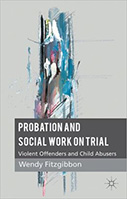Probation and Social Work on Trial: Violent Offenders and
Child Abusers

Author: Wendy Fitzgibbon
Publisher: Houndsmill, Basington, UK; New York: Palgrave Macmillan, 2011. 216p.
Reviewer: Jill Annison | May 2014
Coming from a similar background as the author, having originally worked as a probation practitioner and being now in the criminological field as an academic, I was keen to read the distinctive research approach and analysis promised by Wendy Fitzgibbon’s Probation and Social Work on Trial book. Given the fracture that has taken place between probation and social work in England and Wales over the period under consideration, I was intrigued to see how these now separate arenas of policy and practice would be encompassed within this publication. In this respect I was not disappointed; this account provides an extensive review of four significant cases – and the responses to them – over a forty year period. While the situations are all very different, Fitzgibbon recognises that “when murder occurs by someone already known to, and under the legal surveillance of, probation officers or when a vulnerable child already under the supervision of child protection social workers becomes a victim at the hands, not of strangers but of family members already know to those same social workers, then the sense of frustration will be all the more acute because the murder will be seen to have been preventable” (pages 5-6). In this respect the reverberations of such cases cannot be overstated, nor the sense of tragedy ignored. In taking these concerns on board, Fitzgibbon applies an in-depth and nuanced critique, incorporating a historical perspective and providing a comprehensive account through an interrogation of wider changes within society.
Early on in the book Fitzgibbon points out that the occurrence of such cases is thankfully rare; the absolute numbers of child abuse related deaths in England and Wales have fallen, both in terms of actual numbers and as indicated by the rate per million children over the period under consideration. In relation to the national probation caseload (England and Wales), she reports that serious further offences (SFOs) committed by offenders under probation supervision amounted to just 0.2% of the caseload in 2008, with murder, attempted murder and manslaughter cases involving even fewer cases. Nevertheless, she notes the high public profile that such cases attract and emphasises that “a death is a tragedy and all available strategies for preventing recurrence must be given serious consideration” (page 13). This statement informs and underpins the subsequent exploration and analysis in the book. Fitzgibbon investigates the moral panic that has ensued from such cases and develops a detailed critique of the current application of formulaic risk-based procedures and targets, which are decontextualized from their wider social and political contexts. In order to address this lacuna, she draws on and develops the Left Realist ‘square of crime’ to take account of four interacting components: media, government, community and agency (i.e. child protection and probation).
The above theoretical perspective puts in place an underpinning structure and analytical framework for the book, enabling Fitzgibbon to review in detail the four cases under consideration (the child abuse cases of Maria Colwell in 1973 and Baby P [Peter Connelly] in 2007; and the murders carried out by Graham Young in 1971 and by Sonnex and Farmer in 2008). After an introduction, Fitzgibbon applies a specific focus to each subsequent chapter. This approach serves her well in providing breadth of coverage, while also allowing key insights and a penetrating critique to emerge. Her account is illustrated with quotes from interviews with 16 managers and practitioners situated across the probation and social work fields. These responses provide convincing accounts and insights into the ‘real life’ pressures and experiences of working at the front-line and provide an illuminating additional dimension to Fitzgibbon’s account.
In terms of the book’s structure, Fitzgibbon conducts an exploration into each specific area under consideration within the main substantive chapters, building to a review of the implications arising from these different perspectives in the concluding chapter. In Chapter 2, ‘Media Responses,’ she draws on extracts from contemporaneous reports of the various cases, delving into the implications of what she describes as ‘media moral panic’. The extent of her coverage in this chapter is impressive and she puts forward some well-made and well-supported points about the fragmentation of society and the power of the media. However, in this chapter and the next focusing on ‘Family, Community and Violence’, I thought that at times there was a rather romanticised view of ‘the community’ from the past, and indeed of the supposed connections between local people and state agencies, such as probation and social work. Nevertheless, in turning her focus to the present, Fitzgibbon conveys an incisive criticism of significant issues: the current focus on risk assessment and risk management; unskilled practitioners working with high caseloads; the emphasis on adhering to process rather than developing relationships; and all of this taking place within a context of “tick box” and target-driven organisational cultures.
These concerns lead appropriately into Chapter 4 which covers ‘Political Responses and Inquiries.’ Fitzgibbon reviews the changes during the period under consideration in response to such events. In terms of the Baby P case, she highlights the politicised and litigious conflict that ensued, and the emphasis on managerial failings. This was done, she says, rather than undertaking an in-depth analysis of the target-driven and risk-management orientation of social workers’ interventions. She goes on to draw parallels with the official conclusions drawn from the Sonnex case, with the forceful observation that existing procedures and methods of work were merely tweaked, while underlying problems were denied or overlooked.
Fitzgibbon then turns her attention in Chapter 5 to ‘The Demise of Probation and Social Work Practice.’ I found this chapter riveting to read. It contains a penetrating level of analysis, and the author alights on some critical aspects of recent developments. First, she highlights the shift away from face-to-face work because of incessant demands of bureaucratic accountability. She then identifies the crucial importance of timely and meaningful inter-agency collaboration, but starkly points out that this is inevitably one of the first casualties of high workloads and lack of resources. Moreover, Fitzgibbon argues that such collaboration is often impeded, rather than assisted, by the pre-configured formats of different in-house IT templates. Last, but by no means least, she notes that the focus on processing and collating information results in the loss of meaningful and holistic overviews of actual situations. These different facets are explored via quotes from her qualitative interviews, which provide a sense of the very real tensions experienced on the frontline of these agencies.
Given the Transforming Rehabilitation agenda of the Coalition Government in England and Wales (Ministry of Justice 2013), the timeliness and relevance of the issues discussed in this chapter are clear. Fitzgibbon’s emphasis on the importance of thinking ‘outside the risk score’ is of particular salience given the Government’s plans to divide up responsibility for the supervision of offenders according to the level of harm (with low and medium risk offenders being dealt with by newly created Community Rehabilitation Companies, while high risk offenders will be overseen by the National Probation Service). This approach would seem to ignore the dynamic nature of risk, and Fitzgibbon concludes that “the client becomes deconstructed into a bundle of risks and the holistic picture is lost” (page 140). This bleak warning should surely be taken on board by managers and politicians alike.
The concluding chapter draws the various strands together, with Fitzgibbon bemoaning the decline of community in deprived areas. She makes valid points in relation to social work’s diminishing engagement with local networks as caring resources and also the problems caused by probation’s withdrawal from communities at a time when locally-grounded desistance models have much to offer. The author takes a gloomy view of the direction of the Coalition Government’s plans, highlighting the drive towards privatisation and the neo-liberal orientation of policy which has had such a devastating impact on the poor in society. In drawing the book to a close, Fitzgibbon comments on the signs she had nevertheless noted on the part of practitioners to challenge the ‘one-dimensional orientation to risk management,’ foreseeing a political clash in this respect. However, resistance has been relatively muted, and the Government’s plans continue in a seemingly unstoppable way. For probation the Transforming Rehabilitation ‘omnishambles’ moves on apace (Brown 2013), while media criticisms of social services – ‘And still they die: up to 110 since Baby P’ (Arbuthnott 2013) – generate still more moral panic. In this respect, Fitzgibbon’s book is an important, timely and thought-provoking account.
References
Arbuthnott, G. (2013). ‘And Still They Die: Up to 110 Since Baby P’, The Sunday Times, News Section, Page 18, published on 27th October, 2013.
Brown, Jim (2013). On Probation blog, last accessed at http://probationmatters.blogspot.co.uk/ on 25th November, 2013.
Ministry of Justice (2013). Transforming Rehabilitation last accessed at http://www.justice.gov.uk/transforming-rehabilitation on 25th November, 2013.
Jill Annison, Associate Professor (Senior Lecturer), Plymouth University.


